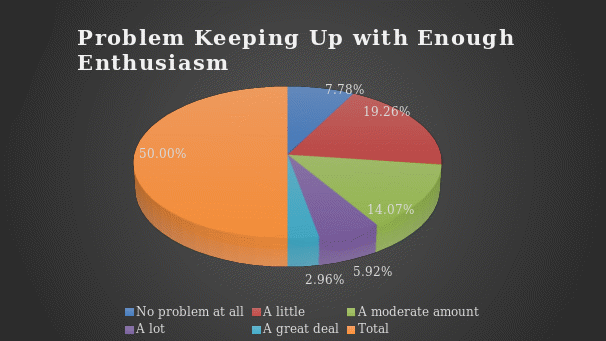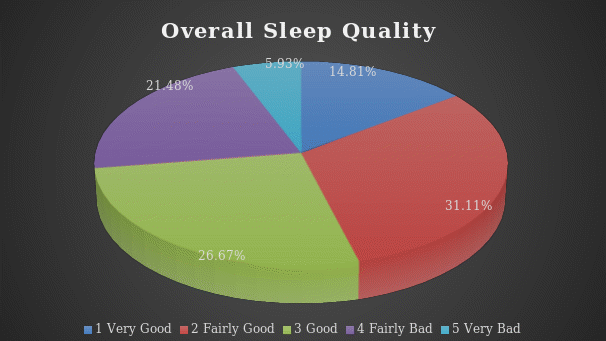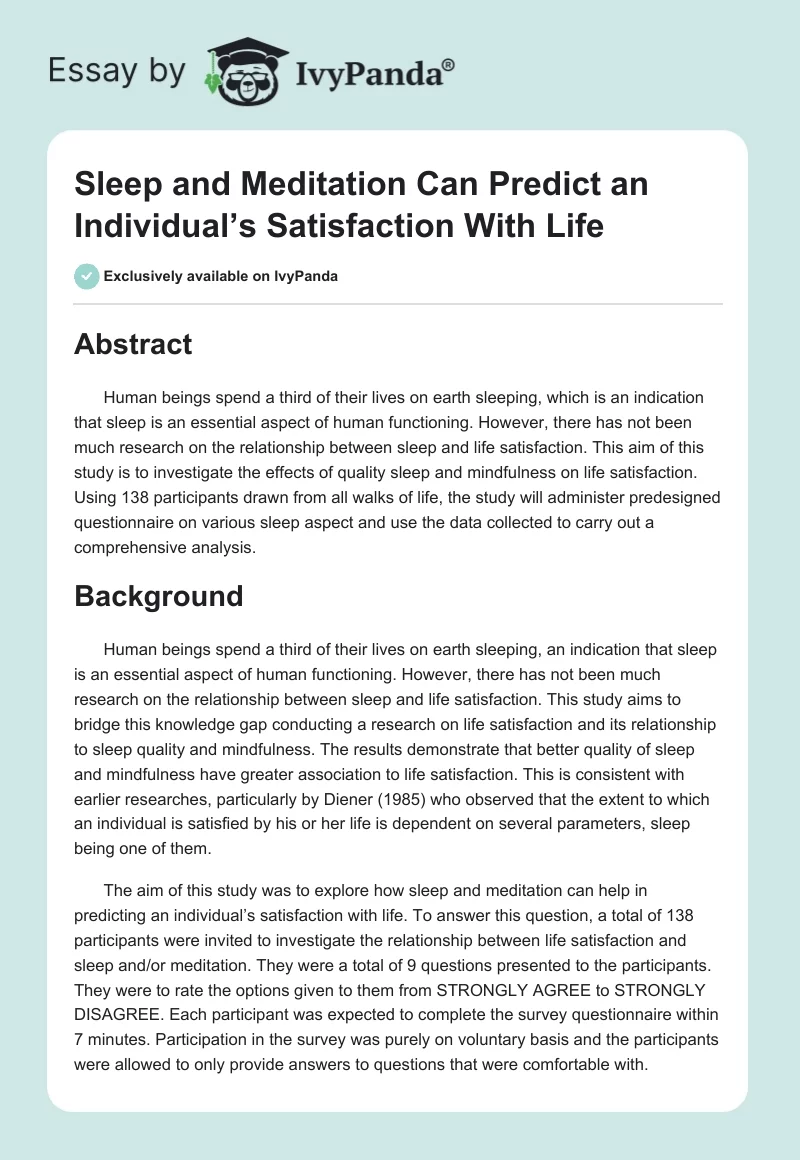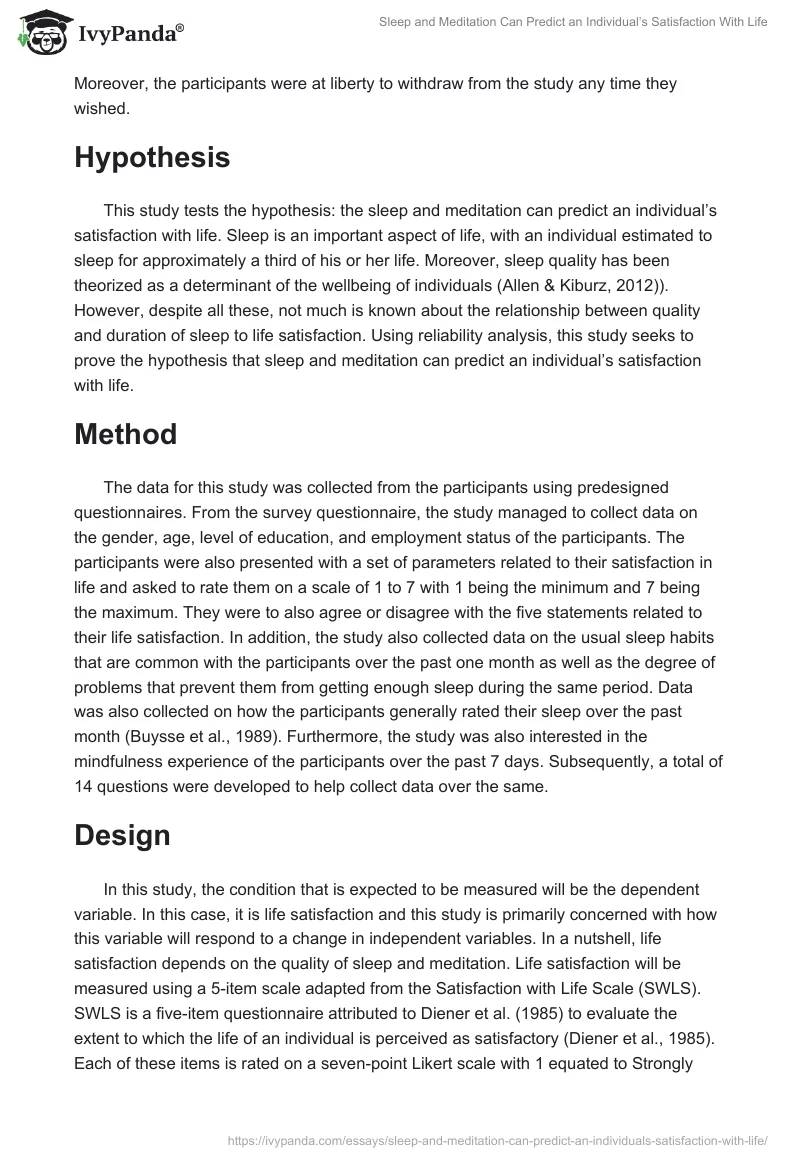Abstract
Human beings spend a third of their lives on earth sleeping, which is an indication that sleep is an essential aspect of human functioning. However, there has not been much research on the relationship between sleep and life satisfaction. This aim of this study is to investigate the effects of quality sleep and mindfulness on life satisfaction. Using 138 participants drawn from all walks of life, the study will administer predesigned questionnaire on various sleep aspect and use the data collected to carry out a comprehensive analysis.
Background
Human beings spend a third of their lives on earth sleeping, an indication that sleep is an essential aspect of human functioning. However, there has not been much research on the relationship between sleep and life satisfaction. This study aims to bridge this knowledge gap conducting a research on life satisfaction and its relationship to sleep quality and mindfulness. The results demonstrate that better quality of sleep and mindfulness have greater association to life satisfaction. This is consistent with earlier researches, particularly by Diener (1985) who observed that the extent to which an individual is satisfied by his or her life is dependent on several parameters, sleep being one of them.
The aim of this study was to explore how sleep and meditation can help in predicting an individual’s satisfaction with life. To answer this question, a total of 138 participants were invited to investigate the relationship between life satisfaction and sleep and/or meditation. They were a total of 9 questions presented to the participants. They were to rate the options given to them from STRONGLY AGREE to STRONGLY DISAGREE. Each participant was expected to complete the survey questionnaire within 7 minutes. Participation in the survey was purely on voluntary basis and the participants were allowed to only provide answers to questions that were comfortable with. Moreover, the participants were at liberty to withdraw from the study any time they wished.
Hypothesis
This study tests the hypothesis: the sleep and meditation can predict an individual’s satisfaction with life. Sleep is an important aspect of life, with an individual estimated to sleep for approximately a third of his or her life. Moreover, sleep quality has been theorized as a determinant of the wellbeing of individuals (Allen & Kiburz, 2012)). However, despite all these, not much is known about the relationship between quality and duration of sleep to life satisfaction. Using reliability analysis, this study seeks to prove the hypothesis that sleep and meditation can predict an individual’s satisfaction with life.
Method
The data for this study was collected from the participants using predesigned questionnaires. From the survey questionnaire, the study managed to collect data on the gender, age, level of education, and employment status of the participants. The participants were also presented with a set of parameters related to their satisfaction in life and asked to rate them on a scale of 1 to 7 with 1 being the minimum and 7 being the maximum. They were to also agree or disagree with the five statements related to their life satisfaction. In addition, the study also collected data on the usual sleep habits that are common with the participants over the past one month as well as the degree of problems that prevent them from getting enough sleep during the same period. Data was also collected on how the participants generally rated their sleep over the past month (Buysse et al., 1989). Furthermore, the study was also interested in the mindfulness experience of the participants over the past 7 days. Subsequently, a total of 14 questions were developed to help collect data over the same.
Design
In this study, the condition that is expected to be measured will be the dependent variable. In this case, it is life satisfaction and this study is primarily concerned with how this variable will respond to a change in independent variables. In a nutshell, life satisfaction depends on the quality of sleep and meditation. Life satisfaction will be measured using a 5-item scale adapted from the Satisfaction with Life Scale (SWLS). SWLS is a five-item questionnaire attributed to Diener et al. (1985) to evaluate the extent to which the life of an individual is perceived as satisfactory (Diener et al., 1985). Each of these items is rated on a seven-point Likert scale with 1 equated to Strongly Agree and 7 being Strongly Disagreeing (Querstret & Cropley, 2012). SWLS has demonstrated adequate construct validity that includes positive correlations with positive affect measures and alternative well-being subjective measures with psychological distress measures.
The SWLS five items are explanations or features of a satisfied life led by an individual. These items include;
- In most ways my life is close to my ideal world
- The conditions of my life are excellent
- I am satisfied with my life
- So far, I have gotten the important things in life
- If I could live my life over, I would change almost nothing.
These are the items that indicate whether an individual is satisfied with his life or not. Incidentally, these five items can be measured using the quality of sleep and meditation.
The influences of mindfulness are assessed using Freiburg Mindfulness Inventory (FMI) and two subscales presence and acceptance. Sleep quality is assessed using the Pittsburgh Sleep Quality Index (PSQI). The FMI is a significant, reliable, and valid questionnaire that is used to measure mindfulness. Though it emanates from the Buddhist BACKGROUND form of mind measuring, it can be used in wider contexts. It contains all the 14 items that characterize all the perspectives of mindfulness. This inventory is mainly concerned with characterizing mindfulness experiences.
To get the summary score, all the items are added up. However, it must be noted that there are some reverse items that must be observed when scoring. This means that the scoring should be reversed using a recode command that will recode 1 into 4. The recode command will also be able to recode 2 into 3, 4 into 1, and 3 into 2. For instance, when recoding the item “I am impatient with myself and with others,” there will be no need to use distinct factor scale scores. However, if there will be a need to do so, the data set will be analyzed to extract the factors of 4 to 6 in accordance with the data structure that will be available.
Participants
Overall, a total of 142 participants were sampled to take part in the study; 119 females, 20 males, and 2 non-binaries. However, one participant did not disclose his or her gender. Not all the 142 samples participated in the study. 3 of them did not sign the consent form. This means that 139 participants signed the consent forms and proceeded to answer the questionnaires and even offered their socio-demographic information. All the participants were aged between 18 and 69 years old. However, the majority of the participants fell within the age bracket of 40 and 49, followed by those between 30 and 39 years old. Only 4 participants were more than 60 years of age. All the participants were fairly educated. The majority of them were undergraduates and postgraduates. Only 2 of them lacked formal education. 4 of them had vocational training while 8 were Ph.D. holders. This means that the study relied on a group of samples that mainly understood the depth of the questionnaire and could hence be trusted to provide valid information.
Moreover, the participants comprised of individuals who were economically engaged in various activities. 79 of them were employed on a full-time basis while 36 were part-time employees. Conversely, only one was retired and 14 were students while 12 were unemployed. It must be noted that the type of economic engagement or lack of it is a significant determining factor of sleep quality. Thus, this is a sample that is perfectly designed to collect the required data for the study that will adequately prove the hypothesis.
Apparatus
The participants were issued with pre-designed questionnaires and given 7 minutes to fill.
Procedure
The questionnaires were emailed to them and were to be filled online. The site became inactive immediately the seven minutes elapsed.
Results
Women formed the bulk of the participants, making up to 83.80% while 14.08% were males. 1.41% were of non-binary gender whereas 0.70% preferred not to disclose their gender. The majority of the participants were aged between 40 and 49 years old. On the other hand, only 4 participants were over the age of 60. Meanwhile, the majority of the participants had formal education and full-time jobs. Statistically, the majority of the participants (12.41%) strongly agreed that they had attained the important things they want in their lives. On the other hand, the participants who strongly agreed that they would change almost nothing if they could live their lives over again were the fewest (2.19%).
During the past month, experiencing pain at night and waking up to take medication was identified as the most popular causative factors for trouble sleeping. On the other hand, waking up in the middle of the night or early morning was highlighted as the least popular causative factor of trouble sleeping (Walach et al., 2006). The figures changed disproportionately when the duration changed to less than one week, once or twice a week, and three or more time a week.

When it came to having enthusiasm to get things done, 38.52% of the participants disclosed that they only had a little problem while 5.93% confessed that they had a great deal of problems over the same during the last month. During the same period, 26.67% of the participants rated their sleep as Good while only 5.93% stated that their sleep was Very Bad.

Discussion
From the results obtained, it is apparent that the hypothesis of this study has been proven to be true. To carry out an analysis of this study, SPSS version 22.0 for Windows will be used. A complete sample will be used to perform all the analyses. There will be a modified sample that consists of participants under the age of 18 years old that will be used as a control experiment. Participants in this age category are not known to experience trouble sleeping as they are generally satisfied with their lives. Most of them do not have a lot of responsibilities that would compromise the quality of sleep. For all the variables, the presence of a normal distribution will be visually inspected. Moreover, t-tests will be used to investigate gender differences with regard to life satisfaction.
The relationship between the variables of overall life satisfaction and the 5 items will be calculated using Pearson correlation analysis. In addition, to analyze the implications of gender, age and general life satisfaction variable will be conducted using a stepwise multiple regression model. In this model, the overall life satisfaction will be used as the independent variable. Incidentally, the stepwise method is known for its exploratory feature, hence, the reason why it will be selected for this analysis. Moreover, to further investigate in detail the particular influence of the life satisfaction variable and the demographic personality on the overall life satisfaction, the study will a hierarchal regression analysis.
The aim of this study was to investigate how various perspectives of sleep affect life satisfaction among a random sample. The results have demonstrated that indeed various sleep variables are related to life satisfaction. Better quality of sleep, longer mean duration of sleep, and less sleep duration variability have all been identified as having the association with greater life satisfaction. Therefore, the hypothesis was supported by the results of this study. However, since this study assumes a cross-sectional design, temporal relations directions cannot be immediately established. It is possible for the relationships to be bidirectional, which implies that disturbed sleep affects how satisfactory the participants judge their life.
On the other hand, some studies have shown that the quality of sleep indeed affects life satisfaction. There has not been any evidence found to prove the existence of a reverse relationship, nonetheless. From these results, sleep affects the satisfaction with life more than an individual’s life satisfaction affects his or her sleep. There could be many explanations that justify the relationship between life satisfaction and sleep deviation. There might be a third variable such as personality disorder that affects this relationship.
From the study, it is evident that the variability of sleep duration has strong correlations with the rise in time deviation. The fact that these two variables overlap can be used as an explanation as to why sleep duration variability is a significant determinant of life satisfaction. The results of this study are consistent with previous studies that have concluded that better quality of sleep has moderate associations with greater satisfaction in life. For instance, Pilcher’s findings demonstrated that the relation coefficient between sleep quality and life satisfaction was considerably higher as compared to mean sleep duration and life satisfaction. It must be noted that the sample used mainly comprises a younger population of middle ages. This study also experimented with how meditation can predict an individual’s satisfaction with life.
Limitations
Outliers refer to unusual values in the dataset, which carry the risk of distorting the statistical analysis and violating the study’s assumptions or hypothesis. The aspects of sleep that were used in this study were not obtained as a result of any credible scientific research. All the variable were as a result of theories developed from previous studies. Thus, the measure of sleep quality for this study was self-created. In addition, the measure of sleep quality used in this study had some internal reliability margin of error.
Sleep quality is a wide construct that consists of items that inter-correlate as compared to highly phrased items of similar constructs that constitute SWLS. A Cronbach’s Alpha is sufficient for a 3-item measure of sleep quality. To further support the sleep quality index, it would have been advantageous to use additional validation such as criterion-related validity. However, this approach would have affected the overall relevance of this study’s findings. Furthermore, sleep quality is the only variable that has several existing types of researches that allow for more conclusive findings related to its association with life satisfaction or wellbeing in diverse population groups.
Studies have suggested that most people do not assess the duration of time they spend sleeping. The few who do so do not do it accurately even in the morning after they wake up. In addition, some studies have indeed established that participants underestimate the number of hours they spend sleeping. However, such studies have often relied on special populations and smaller samples. This means that their results cannot be comparable to those of the current study.
Majority of the sampled population comprised relatively younger people. This is a special population group that is mostly influenced by peer pressure and an inclination to fit into society. Thus, there might have been biases in answering the question related to the quality of life. Studies have shown that most young people do not want to admit openly that they are not leading satisfying lives. Therefore, some might have given inaccurate answers out of peer pressure or for self-gratification. This means that the study might have some biases that were included in the final computation.
To get rid of outliers, it would be advisable to use nonparametric hypothesis tests, which will ensure that the outliers do not necessarily distort the final results or breach their assumptions. Another option is to use regression analysis, which can help in transforming data. Moreover, the use of bootstrapping technique makes use of the sample data, which prevents the skewing of results and dataset violations.
References
Allen, T. D., & Kiburz, K. M. (2012). Trait mindfulness and work–family balance among working parents: The mediating effects of vitality and sleep quality. Journal of vocational behavior, 80(2), 372-379.
Diener, E., Emmons, R. A., Larsen, R. J., & Griffin, S. (1985). The Satisfaction with Life Scale. Journal of Personality Assessment, 49, 71-75.
Buysse, DJ, Reynolds CF, Monk TH, Berman SR, Kupfer (1989). The Pittsburgh Sleep Quality Index (PSQI): A new instrument for psychiatric research and practice. Psychiatry Research 28:193-213.
Querstret, D., & Cropley, M. (2012). Exploring the relationship between work-related rumination, sleep quality, and work-related fatigue. Journal of occupational health psychology, 17(3), 341.
Walach, H., Buchheld, N., Buttenmuller, V., Kleinknecht, N., Schmidt, S. (2006). Measuring Mindfulness–The Freiburg Mindfulness Inventory (FMI). Personality and Individual Differences, 40, 1543-1555.


